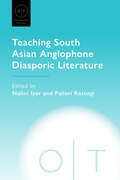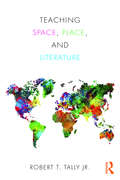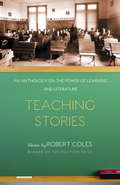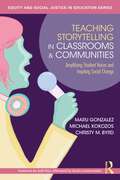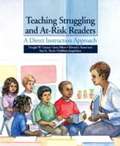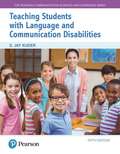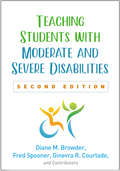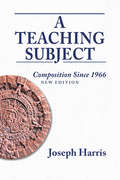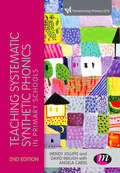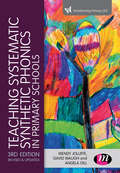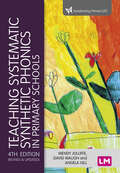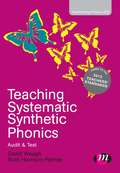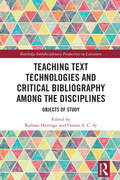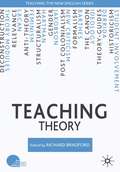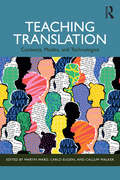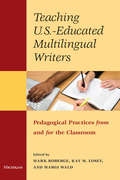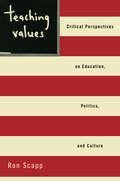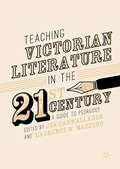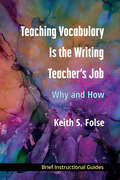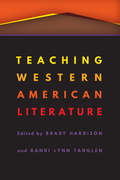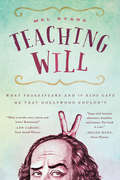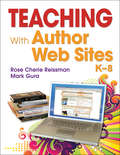- Table View
- List View
Teaching South Asian Anglophone Diasporic Literature (Options for Teaching)
by Nalini Iyer and Pallavi RastogiMigration from the Indian subcontinent began on a large scale over 150 years ago, and today there are diasporic communities around the world. The identities of South Asians in the diaspora are informed by roots in the subcontinent and the complex experiences of race, religion, nation, class, caste, gender, sexuality, language, trauma, and geography. The literature that arises from these roots and experiences is diverse, powerful, and urgent.Teaching South Asian Anglophone Diasporic Literature embraces an intersectionality that attends to the historical and material conditions of cultural production, the institutional contexts of pedagogy, and the subject positions of teachers and students. Encouraging a deep engagement with works whose personal, political, and cultural insights are specific to South Asian diasporic consciousness, the volume also provokes meaningful reflection on other literatures in an age of increasing migration and diaspora.
Teaching Space, Place, and Literature
by Robert T. Tally Jr.Space, place and mapping have become key concepts in literary and cultural studies. The transformational effects of postcolonialism, globalization, and the rise of ever more advanced information technologies helped to push space and spatiality into the foreground, as traditional spatial or geographic limits are erased or redrawn. Teaching Space, Place and Literature surveys a broad expanse of literary critical, theoretical, historical territories, as it presents both an introduction to teaching spatial literary studies and an essential guide to scholarly research. Divided into sections on key concepts and issues; teaching strategies; urban spaces; place, race and gender and spatiality, periods and genres, this comprehensive book is the ideal way to approach the teaching of space and place in the humanities classroom.
Teaching Stories
by Robert ColesThe Call of Stories presents a study of how listening to stories promotes learning and self-discovery. Copyright © Libri GmbH. All rights reserved.
Teaching Storytelling in Classrooms and Communities: Amplifying Student Voices and Inspiring Social Change (Equity and Social Justice in Education Series)
by Maru Gonzalez Michael Kokozos Christy M. ByrdUnleash the transformative power of storytelling to build belonging, ignite critical consciousness, and amplify students’ voices. This dynamic book equips educators who work with middle and high school aged youth to teach storytelling in their classrooms or community organizations.Through inspiring examples and hands-on teaching strategies, the authors show you how to build trust and foster community, explore diverse storytelling modes and formats, guide students in developing effective and ethical social impact stories, and more. You’ll also discover practical tools to help students broaden their story’s reach and impact through collaboration and coalition building. Each chapter brims with student examples, ready-to-use teaching tips, and experiential activities, plus questions designed to spark dialogue and help students awaken and embrace the storyteller within. There are also reflective prompts to support your own journey as both a facilitator and participant in the storytelling exchange.Packed with practical resources, moving narratives, and actionable tips, this book is your essential guide to cultivating a supportive learning community, increasing student engagement, and unlocking young people’s leadership potential through the vehicle of storytelling.
Teaching Struggling and At-Risk Readers: A Direct Instruction Approach
by Jerry Silbert Douglas W. Carnine Edward J. Kame'Enui Sara G. Tarver Kathleen JongjohannTeaching Struggling and At-Risk Readers: A Direct Instruction Approach is designed to provide specific information to assist educators in being effective teachers of reading with all of their students. This three-part book provides information on incorporating instructional design and delivery principles into daily instruction for students at the beginning and primary stages of reading. It discusses: Structuring initial teaching procedures so teaching presentations are clear and foster a high degree of interaction between teachers and students. Using language and demonstration techniques that can be understood by all students. Sequencing the instruction of reading content to ensure essential skills and knowledge are taught in an aligned and coherent manner. Using techniques that provide adequate practice and review for students in developing high levels of fluency and accuracy.
Teaching Students With Language And Communication Disabilities
by S. KuderDesigned for special education teachers, this text contains numerous case studies illustrating the impact of language disorders on students and on classrooms. The book includes descriptions of language disabilities by category of disability, and contains activities for group or individual projects.
Teaching Students with Moderate and Severe Disabilities, Second Edition
by Diane M. Browder Fred Spooner Ginevra R. Courtade and ContributorsFor years the text of choice for developing excellence as a teacher of K–12 students with moderate and severe disabilities, this clearly written work has now been revised and updated. Chapters provide step-by-step procedures for designing standards-based individualized education plans and evaluating and enhancing student progress. Methods and materials for teaching literacy, mathematics, science, and social studies are described in depth. The book also describes effective ways to build functional daily living skills. User-friendly features include extensive vignettes and classroom examples, end-of-chapter application exercises, and reproducible planning and assessment tools. Purchasers get access to a Web page where they can download and print the reproducible materials in a convenient 8 1/2" x 11" size. New to This Edition *Reflects important advances in research and evidence-based practice. *Chapter on collaborating with culturally diverse families, plus a stronger multicultural focus throughout. *Chapter on writing instruction. *Two additional chapters on reading and math, ensuring coverage of both foundational and grade-aligned skills. *Increased attention to students with autism spectrum disorder and to uses of technology.
Teaching Subject, A: Composition Since 1966, New Edition (G - Reference,information And Interdisciplinary Subjects Ser.)
by Joseph HarrisIn this classic text, Joseph Harris traces the evolution of college writing instruction since the Dartmouth Seminar of 1966. A Teaching Subject offers a brilliant interpretive history of the first decades during which writing studies came to be imagined as a discipline separable from its partners in English studies. Postscripts to each chapter in this new edition bring the history of composition up to the present. Reviewing the development of the field through five key ideas, Harris unfolds a set of issues and tensions that continue to shape the teaching of writing today. Ultimately, he builds a case, now deeply influential in its own right, that composition defines itself through its interest and investment in the literacy work that students and teachers do together. Unique among English studies fields, composition is, Harris contends, a teaching subject.
Teaching Systematic Synthetic Phonics in Primary Schools (Transforming Primary QTS Series)
by David Waugh Angela Carss Wendy JolliffeThe government prioritizes systematic synthetic phonics as a key strategy in the teaching of reading and this text supports trainee teachers working towards primary QTS in how to use phonics effectively. The text begins by examining the central role of phonics in the teaching of reading, drawing on recent research and initiatives. It goes on to cover the essential knowledge trainees need to acquire themselves for the teaching of phonics to children. Accessible and relevant, the text uses case studies and useful research to support trainees in becoming competent and confident in the teaching of phonics. Supplement this text with the companion audit and test book: Teaching Systematic Synthetic Phonics Audit and Test About the Transforming Primary QTS series This series reflects the new creative way schools are begining to teach, taking a fresh approach to supporting trainees as they work towards primary QTS. Titles provide fully up to date resources focused on teaching a more integrated and inclusive curriculum, and texts draw out meaningful and explicit cross curricular links.
Teaching Systematic Synthetic Phonics in Primary Schools (Transforming Primary QTS Series)
by David Waugh Wendy Jolliffe Angela GillThe government prioritizes systematic synthetic phonics as a key strategy in the teaching of reading and this is your guide to teaching systematic synthetic phonics in primary schools. This text supports trainee teachers working towards primary QTS through the exploration of a range of aspects of phonics teaching. It gives a balance of research and practice and allows trainees to develop and in-depth understanding of what works in phonics teaching, and why. It begins with the subject knowledge that underpins effective teaching - key aspects of the alphabetic code from discriminating sounds and phonemes to teaching long vowel phonemes and their different spellings and pronunciations. It goes on to explore pedagogy from the early years to Key Stage 2 giving guidance on, among others, systematic progression, intervention and multi-sensory and interactive methods. The title includes a review of different popular phonics programmes, set against the DfE (2011) criteria for high-quality phonics teaching. This third edition has been updated in line with changes in primary education. A new section includes classroom case studies and lesson ideas for teachers to learn about best practice from other teachers.
Teaching Systematic Synthetic Phonics in Primary Schools (Transforming Primary QTS Series)
by David Waugh Wendy Jolliffe Angela GillThe government prioritizes systematic synthetic phonics as a key strategy in the teaching of reading and this is your guide to teaching systematic synthetic phonics in primary schools. This text supports trainee teachers working towards primary QTS through the exploration of a range of aspects of phonics teaching. It gives a balance of research and practice and allows trainees to develop and in-depth understanding of what works in phonics teaching, and why. It begins with the subject knowledge that underpins effective teaching - key aspects of the alphabetic code from discriminating sounds and phonemes to teaching long vowel phonemes and their different spellings and pronunciations. It goes on to explore pedagogy from the early years to Key Stage 2 giving guidance on, among others, systematic progression, intervention and multi-sensory and interactive methods. The title includes a review of different popular phonics programmes, set against the DfE (2011) criteria for high-quality phonics teaching. This third edition has been updated in line with changes in primary education. A new section includes classroom case studies and lesson ideas for teachers to learn about best practice from other teachers.
Teaching Systematic Synthetic Phonics in Primary Schools (Transforming Primary QTS Series)
by David Waugh Wendy Jolliffe Angela GillThe government prioritizes systematic synthetic phonics as a key strategy in the teaching of reading. This core text is your guide to teaching systematic synthetic phonics in primary schools. The book′s balance of research and practice and its focused approach enables you to develop an in-depth understanding of what works in phonics teaching, and why. It begins with the subject knowledge that underpins effective teaching and goes on to explore pedagogy from the early years to Key Stage 2. It includes guidance on systematic progression, intervention and multi-sensory and interactive methods. This 4th edition includes a new section ′Challenges in learning and teaching phonics′ supporting you to meet the individual needs of children.
Teaching Systematic Synthetic Phonics in Primary Schools (Transforming Primary QTS Series)
by David Waugh Wendy Jolliffe Angela GillThe government prioritizes systematic synthetic phonics as a key strategy in the teaching of reading. This core text is your guide to teaching systematic synthetic phonics in primary schools. The book′s balance of research and practice and its focused approach enables you to develop an in-depth understanding of what works in phonics teaching, and why. It begins with the subject knowledge that underpins effective teaching and goes on to explore pedagogy from the early years to Key Stage 2. It includes guidance on systematic progression, intervention and multi-sensory and interactive methods. This 4th edition includes a new section ′Challenges in learning and teaching phonics′ supporting you to meet the individual needs of children.
Teaching Systematic Synthetic Phonics: Audit and Test (Transforming Primary QTS Series)
by David Waugh Ruth Harrison-PalmerCan you demonstrate a clear understanding of systematic synthetic phonics? If you are training to be a primary school teacher you need to have, and to demonstrate, a clear understanding of systematic synthetic phonics to meet the Teachers' Standards. This companion text to the popular Teaching Systematic Synthetic Phonics in Primary Schools enables you to audit your knowledge, making you more aware of the subject and the areas in which you need to know more. In all chapters, self audits are accompanied by guidance on next steps for developing your knowledge. All chapters feature sections that link your learning to the classroom, showing you how to use your knowledge to teach phonics. Designed to help build your confidence and develop your knowledge of phonics, this text supports your development as an effective teacher of reading. This is a companion text to: Teaching Systematic Synthetic Phonics in Primary Schools Joliffe, Waugh and Carss David Waugh is Director on Primary PGCE at Durham University where he is also the subject leader for English. He has published extensively in Primary English. David is a former deputy head teacher, was Head of the Education department at University of Hull, and was Regional Adviser for ITT for the National Strategies from 2008 to 2010. Ruth Harrison-Palmer is a former acting head teacher. She has worked for the National Strategies and Cumbria Local Authority as a literacy consultant. Currently Ruth has a senior role in ITE at the University of Cumbria.
Teaching Text Technologies and Critical Bibliography Among the Disciplines: Objects of Study (Routledge Interdisciplinary Perspectives on Literature)
by Barbara Heritage Donna A. C. SyTeaching Text Technologies and Critical Bibliography Among the Disciplines: Objects of Study is a richly illustrated volume consisting of 23 methods-based chapters discussing innovative and often experimental approaches to hands-on teaching with material texts. Featuring 47 contributors whose work ranges from digital humanities, librarianship, curation, and conservation to architecture, culinary history, fine art, literary history, and the history of science, the collection builds on new work in the areas of text technologies and critical bibliography—emerging scholarly approaches being embraced in the humanities. The book features established experts in bibliography, the history of the book, manuscript studies, and textual editing, as well as educators and students who are applying new critical bibliographical methods (e.g., Black bibliography) to their pedagogy. The result is a dynamic cross-disciplinary, cross-generational exchange modeling inclusive pedagogies with textual artifacts and illuminating how object-oriented teaching can harness the insights of diverse branches of practice and learning.
Teaching Theory
by Richard BradfordTeaching Theory offers a selection of essays on the pragmatics, benefits and shortcomings of Theory as a key aspect of literature teaching in universities. They range from reflective discussions of Theory as an intellectual challenge for undergraduates to accounts of the day-to-day problems of planning and teaching courses and implementing Theory.
Teaching Translation: Contexts, Modes and Technologies
by Callum Walker Martin Ward Carlo EugeniThe field of translation and interpreting (T&I) training has been undergoing rapid and far-reaching transformation in recent years, as a result of technological advances and sweeping shifts in the international environment within which T&I seeks to mediate.Teaching Translation: Contexts, Modes and Technologiesprovides across-section of multi-national perspectives on teaching various dimensions of translation both within dedicated programmes and as part of individual modules on translation- adjacent programmes. This volume offers essential up-to-date perspectives to ensure that T&I training remains robust and resilient far into the 21st century.Examining key topics of concern across academia, professional translation practice, and collaborative pedagogies, as well as offering crucial insights from the voices of the trainees themselves, this is an essential text for professionals, scholars, and teachers of translation studies and interpreting studies.
Teaching Translation: Programs, courses, pedagogies
by Lawrence VenutiOver the past half century, translation studies has emerged decisively as an academic field around the world, and in recent years the number of academic institutions offering instruction in translation has risen along with an increased demand for translators, interpreters and translator trainers. Teaching Translation is the most comprehensive and theoretically informed overview of current translation teaching. Contributions from leading figures in translation studies are preceded by a substantial introduction by Lawrence Venuti, in which he presents a view of translation as the ultimate humanistic task – an interpretive act that varies the form, meaning, and effect of the source text. 26 incisive chapters are divided into four parts, covering: certificate and degree programs teaching translation practices studying translation theory, history, and practice surveys of translation pedagogies and key textbooks The chapters describe long-standing programs and courses in the US, Canada, the UK, and Spain, and each one presents an exemplary model for teaching that can be replicated or adapted in other institutions. Each contributor responds to fundamental questions at the core of any translation course – for example, how is translation defined? What qualifies students for admission to the course? What impact does the institutional site have upon the course or pedagogy? Teaching Translation will be relevant for all those working and teaching in the areas of translation and translation studies. Additional resources for Translation and Interpreting Studies are available on the Routledge Translation Studies Portal.
Teaching U.S.-Educated Multilingual Writers: Pedagogical Practices from and for the Classroom
by Mark Roberge Margi Wald Kay M. LoseyThis volume was born to address the lack of classroom-oriented scholarship regarding U.S.-educated multilingual writers. Unlike prior volumes about U.S.-educated multilinguals, this book focuses solely on pedagogy-from classroom activities and writing assignments to course curricula and pedagogical support programs outside the immediate classroom. Unlike many pedagogical volumes that are written in the voice of an expert researcher-theorist, this volume is based on the notion of teachers sharing practices with teachers. All of the contributors are teachers who are writing about and reflecting on their own experiences and outcomes and interweaving those experiences and outcomes with current theory and research in the field. The volume thus portrays teachers as active, reflective participants engaged in critical inquiry. Contributors represent community college, college, and university contexts; academic ESL, developmental writing, and first-year composition classes; and face-to-face, hybrid, and online contexts. This book was developed primarily to meet the needs of practicing writing teachers in college-level ESL, basic writing, and college composition classrooms, but will also be useful to pre-service teachers in TESOL, Composition, and Education graduate programs.
Teaching Values: Critical Perspectives on Education, Politics, and Culture
by Ron ScappIn Teaching Values, Ron Scapp wrests the discussion of values and values-based education away from traditionalists who have long dominated educational debates. While challenging the Right's domination of the discussion of values education, Scapp examines some issues not typically raised by educators and critics on the Left, including the positive role of citizenship and national identity in U.S. education and culture.
Teaching Victorian Literature in the Twenty-First Century
by Jen Cadwallader Laurence W MazzenoThis edited collection offers undergraduate Literature instructors a guide to the pedagogy and teaching of Victorian literature in liberal arts classrooms. With numerous essays focused on thematic course design, this volume reflects the increasingly interdisciplinary nature of the literature classroom. A section on genre provides suggestions on approaching individual works and discussing their influence on production of texts. Sections on digital humanities and "out of the classroom" approaches to Victorian literature reflect current practices and developing trends. The concluding section offers three different versions of an "ideal" course, each of which shows how thematic, disciplinary, genre, and technological strands may be woven together in meaningful ways. Professors of introductory literature courses aimed at non-English majors to advanced seminars for majors will find accessible and innovative course ideas supplemented with a variety of versatile teaching materials, including syllabi, assignments, and in-class activities.
Teaching Vocabulary Is the Writing Teacher's Job: Why and How
by Keith S. FolseWhile most teachers acknowledge the importance of vocabulary in learning a new language, many assume a reading class or other teacher will cover vocabulary. Yet vocabulary plays an essential role in good writing, especially academic writing. Teaching Vocabulary Is the Writing Teacher’s Job explores the serious nature of ESL students’ lexical plight and looks at vocabulary in relation to reading, speaking, listening, and writing proficiency. It also examines the role of vocabulary in ESL writing assessment. In the conclusion, author Keith Folse discusses eight research-based suggestions for writing teachers, including encouraging students to become vocabulary detectives, teaching collocations, testing vocabulary, and teaching paraphrasing and summarizing.
Teaching Western American Literature (Postwestern Horizons)
by Brady Harrison Randi Lynn TanglenIn this volume experienced and new college- and university-level teachers will find practical, adaptable strategies for designing or updating courses in western American literature and western studies. Teaching Western American Literature features the latest developments in western literary research and cultural studies as well as pedagogical best practices in course development. Contributors provide practical models and suggestions for courses and assignments while presenting concrete strategies for teaching works both inside and outside the canon. In addition, Brady Harrison and Randi Lynn Tanglen have assembled insights from pioneering western studies instructors with workable strategies and practical advice for translating this often complex material for classrooms from freshman writing courses to graduate seminars.Teaching Western American Literature reflects the cutting edge of western American literary study, featuring diverse approaches allied with women&’s, gender, queer, environmental, disability, and Indigenous studies and providing instructors with entrée into classrooms of leading scholars in the field.
Teaching Will: What Shakespeare and 10 Kids Gave Me that Hollywood Couldn't
by Mel RyaneWhat happens when an idealist volunteers to introduce Shakespeare to a group of unruly kids? Bedlam. Tears. And hard lessons learned. Convinced that children can relate to Shakespeare's themes--power, revenge, love--Mel Ryane launches The Shakespeare Club at a public school. Teaching Will is a riotous cautionary tale of high hopes and goodwill crashing into the realities of classroom chaos. Every week Mel encounters unexpected comedy and drama as she and the children struggle toward staging a production of A Midsummer Night's Dream. Woven through this fish-out-of-water tale is Mel's own story of her childhood aspirations, her acting identity, and the heartbreaking end of her onstage career. In the schoolyard, Mel finds herself embroiled in jealousy and betrayal worthy of Shakespeare's plots. Fits of laughter alternate with wiping noses as she and the kids discover a surprising truth: they need each other if they want to face an audience and triumph. Teaching Will is an uplifting story of empowerment for dreamers and realists alike.
Teaching With Author Web Sites, K–8
by Mark L. Gura Rose C. ReissmanInviting students and teachers into a fascinating literary community, this innovative guide helps teachers use the Web sites of favorite children's book authors to deepen student engagement in learning.
